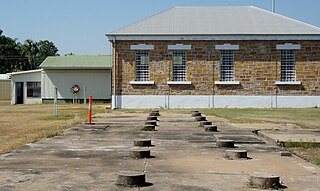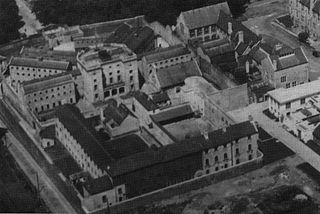
Her Majesty's Prison Maze was a prison in Northern Ireland that was used to house paramilitary prisoners during the Troubles from August 1971 to September 2000. On 15 October 1974 Irish Republican internees burned 21 of the compounds used to house the internees thereby destroying much of Long Kesh.
Harry Bernard Allen was one of Britain's last official executioners, officiating between 1941 and 1964. He was chief executioner at 41 executions and acted as assistant executioner at 53 others, at various prisons in England, Scotland, Northern Ireland, the Channel Islands and Cyprus. He acted as assistant executioner for 14 years, mostly to Albert Pierrepoint from 1941 to 1955.

The Old Melbourne Gaol is a former jail and current museum on Russell Street, in Melbourne, Victoria, Australia. It consists of a bluestone building and courtyard, and is located next to the old City Police Watch House and City Courts buildings, and opposite the Russell Street Police Headquarters. It was first constructed starting in 1839, and during its operation as a prison between 1845 and 1924, it held and executed some of Australia's most notorious criminals, including bushranger Ned Kelly and serial killer Frederick Bailey Deeming. In total, 133 people were executed by hanging. Though it was used briefly during World War II, it formally ceased operating as a prison in 1924; with parts of the jail being incorporated into the RMIT University, and the rest becoming a museum.

H.M. Gaol Hobart or Campbell Street Gaol, a former Australian maximum security prison for males and females, was located in Hobart, Tasmania. Built by convict labour, the gaol operated between 1821 until the early 1960s. In 1961, male inmates were transferred to the H.M. Risdon Prison and in 1963, female inmates were transferred to the Risdon Women's Prison.

Armagh Prison in Armagh, Northern Ireland, is a former prison. The construction of the prison began in 1780 and it was extended in the style of Pentonville Prison in the 1840 and 1850s. For most of its working life Armagh Gaol was the primary women's prison in Ulster. Although the prison is often described as Armagh Women's Gaol, at various points in its history, various wings in the prison were used to hold male prisoners.

Fannie Bay Gaol is a historic gaol in Fannie Bay, Northern Territory, Australia. The gaol operated as Her Majesty's Gaol and Labour Prison, from 20 September 1883 until 1 September 1979.

Hugh McAteer was a volunteer in, and leader of, the Irish Republican Army during their Northern Campaign, and later in 1950 and 1964 unsuccessfully contested for a seat in the British Parliament.

Mountjoy Prison, founded as Mountjoy Gaol and nicknamed The Joy, is a medium security men's prison located in Phibsborough in the centre of Dublin, Ireland. The current prison Governor is Edward Mullins.

Séanna Walsh or Séanna Breathnach is a Sinn Féin member of Belfast City Council and a former volunteer in the Provisional Irish Republican Army (IRA).
The blanket protest was part of a five-year protest during the Troubles by Provisional Irish Republican Army (IRA) and Irish National Liberation Army (INLA) prisoners held in the Maze prison in Northern Ireland. The republican prisoners' status as political prisoners, known as Special Category Status, had begun to be phased out in 1976. Among other things, this meant that they would now be required to wear prison uniforms like ordinary convicts. The prisoners refused to accept that they had been administratively designated as ordinary criminals, and refused to wear the prison uniform.

Sir Charles Lanyon DL, JP was an English architect of the 19th century. His work is most closely associated with Belfast, Northern Ireland.
Thomas Joseph Williams, more commonly known as Tom Williams, was a volunteer in C Company, 2nd Battalion of the Belfast Brigade in the Irish Republican Army from the Bombay Street area of Belfast, Northern Ireland. He was hanged in the Crumlin Road Gaol for his involvement in the killing of Royal Ulster Constabulary (RUC) police officer, Patrick Murphy during the Northern Campaign.
The Northern campaign was a series of attacks by the Irish Republican Army (IRA) Northern Command between September 1942 and December 1944 against the security forces in Northern Ireland. The action taken by the Northern Ireland and the Republic of Ireland governments as a result of these attacks shattered the IRA and resulted in the former being free from IRA activity by the end of World War II.
Kieran Nugent was an Irish volunteer in the Provisional Irish Republican Army (IRA) and best known for being the first IRA 'blanket man' in the Maze Prison in Northern Ireland. When sentenced to three years for hijacking a bus, Nugent refused to wear a prison uniform and said the prison guards would have to "...nail it to my back".
Jimmy Steele was an Irish republican militant and editor. He was one of the most prominent Irish Republican Army (IRA) men in Belfast after the Irish Civil War. Steele spent most of his life in jail as a result of his actions against British security forces.

The Northern Ireland Prison Service is the agency charged with managing prisons in Northern Ireland.
The Maze Prison escape took place on 25 September 1983 in County Antrim, Northern Ireland. HM Prison Maze was a maximum security prison considered to be one of the most escape-proof prisons in Europe. It held prisoners suspected of taking part in armed paramilitary campaigns during the Troubles, with separate wings for loyalists and for republicans. In the biggest prison escape in UK history, 38 Provisional Irish Republican Army (IRA) prisoners escaped from H-Block 7 (H7) of the prison. One prison officer died of a heart attack during the escape and twenty others were injured, including two who were shot with guns that had been smuggled into the prison.
Paul "Dingus" Magee is a former volunteer in the Belfast Brigade of the Provisional Irish Republican Army (IRA) who escaped during his 1981 trial for killing a member of the Special Air Service (SAS) in 1980. After serving a prison sentence in the Republic of Ireland, Magee fled to England where he was imprisoned after killing a policeman in 1992. He was repatriated to the Republic of Ireland as part of the Northern Ireland peace process before being released from prison in 1999, and subsequently avoided extradition back to Northern Ireland to serve his sentence for killing the member of the SAS.
Richard O’Rawe is a former Provisional IRA prisoner and author of Blanketmen.

Cork County Gaol was a former prison located in Cork, Ireland. The main walls and gate entrance of the prison are today incorporated in the perimeter of University College Cork.













